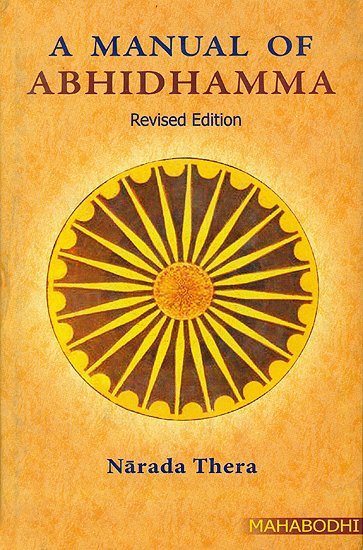A Manual of Abhidhamma
by Nārada Thera | 80,494 words | ISBN-13: 9789380336510
In the Abhidhammattha Sangaha there is a brief exposition of the Law of Dependent Origination, followed by a descriptive account of the Causal Relations that finds no parallel in any other philosophy. Edited in the original Pali Text with English Translation and Explanatory Notes by Narada Maha Thera....
§ 4.
Hetusangahe hetu nāma lobho doso moho alobho adoso amoho c'āti chabbidhā bhavanti.
Tattha pañcadvārāvajjanadvipañcaviññānasampaticchana-santīrana-votthapana-hasana-vasena atthārasāhetukacittāni nāma,
Sesāni sabbāni'pi ekasattati cittāni sahetukān'eva.
Tattha'pi dve momūhacittāni ekahetukāni.
Sesāni dasa akusalacittāni c'eva ñānavippayuttāni dvādasā kāmāvacarasobhanāni c'āti dvāvisati dvihetukacittāni.
Dvādasā ñānasampayutta - kāmāvacara sobhanāni c'eva pañcatimsamahaggata-lokuttara cittāni c'āti satta cattālisa tihetukacittāni.
§ 5.
Lobho doso ca moho ca hetu akusalā tayo Alobhādosāmoho ca kusalābyākatā tathā
Ahetukatthāras'eka hetukā dve dvāvīsati Dvihetukā matā satta cattālisa tihetukā.
(translation)
§ 4.
In the summary of roots (9) there are six-namely, attachment, hatred, delusion or ignorance, non-attachment or generosity, non-anger or good-will and wisdom.
Therein eighteen types of consciousness are without roots (10) - namely, five-door apprehending, the twice fivefold sense-impressions, receiving, investigating, determining, and smiling.
All the remaining seventy-one (11) types of consciousness are with roots.
Of them the two types of consciousness (12) associated with ignorance have only one root.
The remaining ten immoral types (13) of consciousness and the twelve (14) Sense-sphere Beautiful types of consciousness, dissociated with wisdom - thus totaling twenty-two - are with two roots.
The twelve Sense-Sphere Beautiful types (15) of consciousness, associated with wisdom, and the thirty-five Sublime and Supramundane types of consciousness - totaling forty-seven - are with three roots.
§ 5.
Attachment, hatred, and ignorance are the three immoral roots. Similarly non-attachment, good-will, and wisdom are moral and indeterminate (16).
It should be understood that eighteen are without roots, two with one root, twenty-two with two roots and forty-seven with three roots.
Notes-
9. See Ch. 1, N. 9.
For a detailed exposition of hetu see Dhammasangani hetu-gocchakam, Sections 1053-1083; Buddhist Psychology, pp. 274-287.
According to the Atthasālini there are four kinds of hetu:
i. hetu hetu, the root cause or the root condition.
There are three moral hetus, three immoral hetus and three neutral (avyākata) hetus. Here hetu is used in the sense of root.
ii. paccaya-hetu, causal condition or instrumental cause.
"The four Great Essentials (Mahābhūta), o Bhikkhus, are the causes (hetu), the conditions (paccaya) for the manifestation of Form-Group (rūpakkhandha)."
Here hetu is used in the sense of causal relation (paccaya-hetu).
There is a subtle distinction between hetu and paccaya. The former signifies root (mūla); the latter, an aiding factor (upakāraka dhamma). Hetu is compared to the roots of a tree, and paccaya to manure, water and soil that aid its growth.
This distinction should be clearly understood.
It should also be noted that at times both hetu and paccaya are used as synonymous terms.
iii. uttama-hetu, chief cause or condition. A desirable object acts as the chief (uttama) cause in producing a good result and an undesirable one in producing a bad result.
Here it means the chief cause.
iv. sādhārana-hetu, the common cause or condition.
Ignorance is the cause (hetu), condition (paccaya) of volitional activities (sankhārā).
Here hetu is used as the general cause. Just as the essence of both earth and water is the common cause of both sweetness and bitterness, even so ignorance is the common cause of volitional activities.
Though hetu assumes different shades of meaning in the Text, in this particular instance it is used in the specific sense of root.
10. All the ahetuka cittas are devoid of all roots. Hence they are neither moral nor immoral. They are regarded as unmoral.
Seven of them are the resultants of immoral actions, eight of moral actions, and three are merely functionals. See Ch. 1, pp. 27-31.
11. i.e., 89-18 = 71.
12. Namely, the consciousness accompanied by doubt (vicikicchā) and the other accompanied by restlessness (uddhacca). These are the only two types of consciousness that have one root, which is delusion. Being potentially weak, restlessness is powerless in determining a future birth. Both doubt and restlessness are regarded as two Fetters, the first of which is eradicated by the First Path, and the second by the Fourth Path of Sainthood.
13. The first eight immoral types of consciousness are connected with lobha (attachment) and moha (delusion) and the second two with dosa (aversion) and moha. It should be noted that moha is common to all immoral thoughts.
14. Those twelve kāmāvacara sobhana cittas (mentioned in the first chapter) dissociated with ñāna or wisdom are conditioned by the two roots - alobha (non-attachment) and adosa (goodwill or loving-kindness). These two roots coexist in moral thoughts.
15. The remaining twelve kāmāvacara sobhana cittas, accompanied by wisdom, are conditioned by all the three moral roots.
Similarly the 15 types of rūpāvacara consciousness, 12 types of arūpāvacara consciousness, and the 8 types of lokuttara consciousness (15 + 12 + 8 = 35) are always associated with the three moral roots.
It should not be understood that evil thoughts conditioned by immoral roots do not arise in the rūpaloka and the arūpaloka. The point here stressed is that no immoral roots are found in the higher types of consciousness.
Unlike the other kusala cittas, the lokuttara cittas, though associated with the three moral roots, lack procreative power.
16. Avyākata, literally, means that which is not manifested. The term is applied to both vipāka (resultants) and kriyā (Functionals). Vipāka is a result in itself and is not productive of another result. Kriya does not produce any effect. Rūpa (material form) is also regarded as an avyākata because it does not reproduce any karmic result.
Ahetuka - rootless types of consciousness = 18
Ekahetuka - types of consciousness with one root = 2
Dvihetuka - types of consciousness with two roots immoral = 10
moral = 12
Tihetuka - types of consciousness with three roots Beautiful = 12
Sublime = 27
Supramundane = 8
________
total = 89
